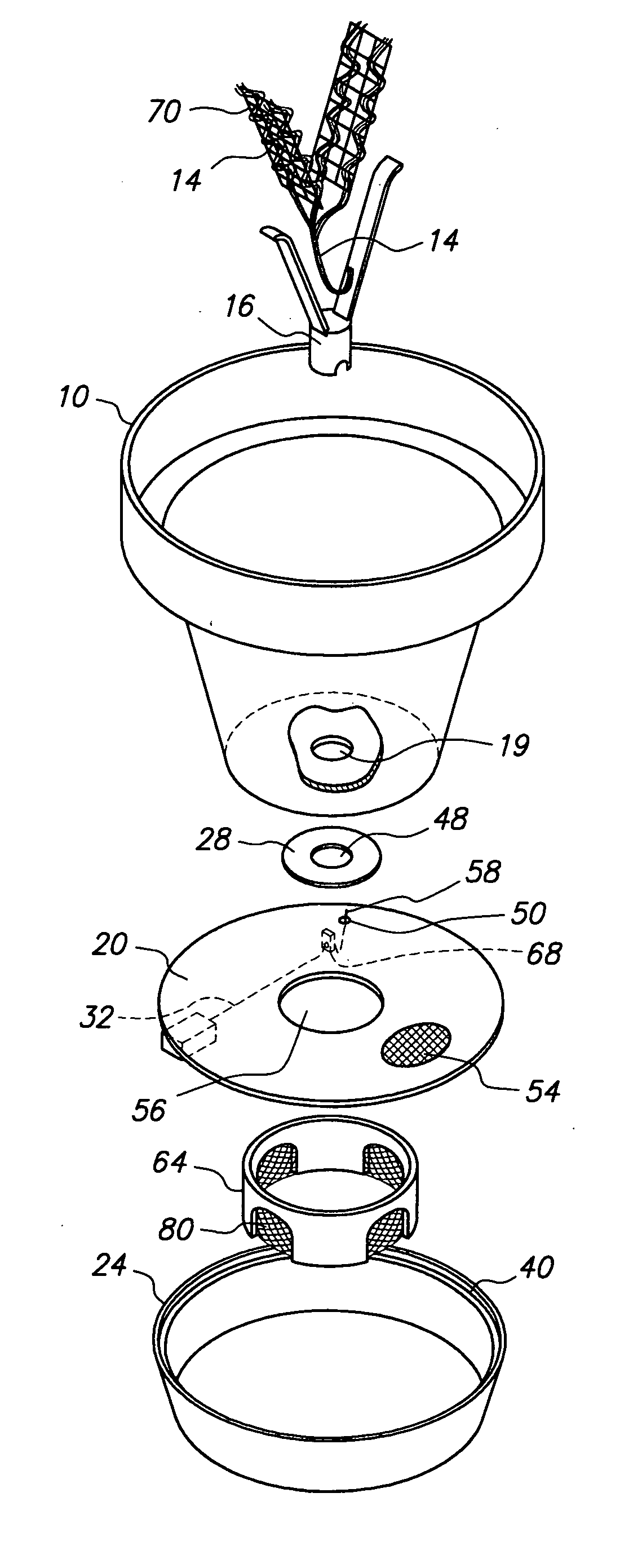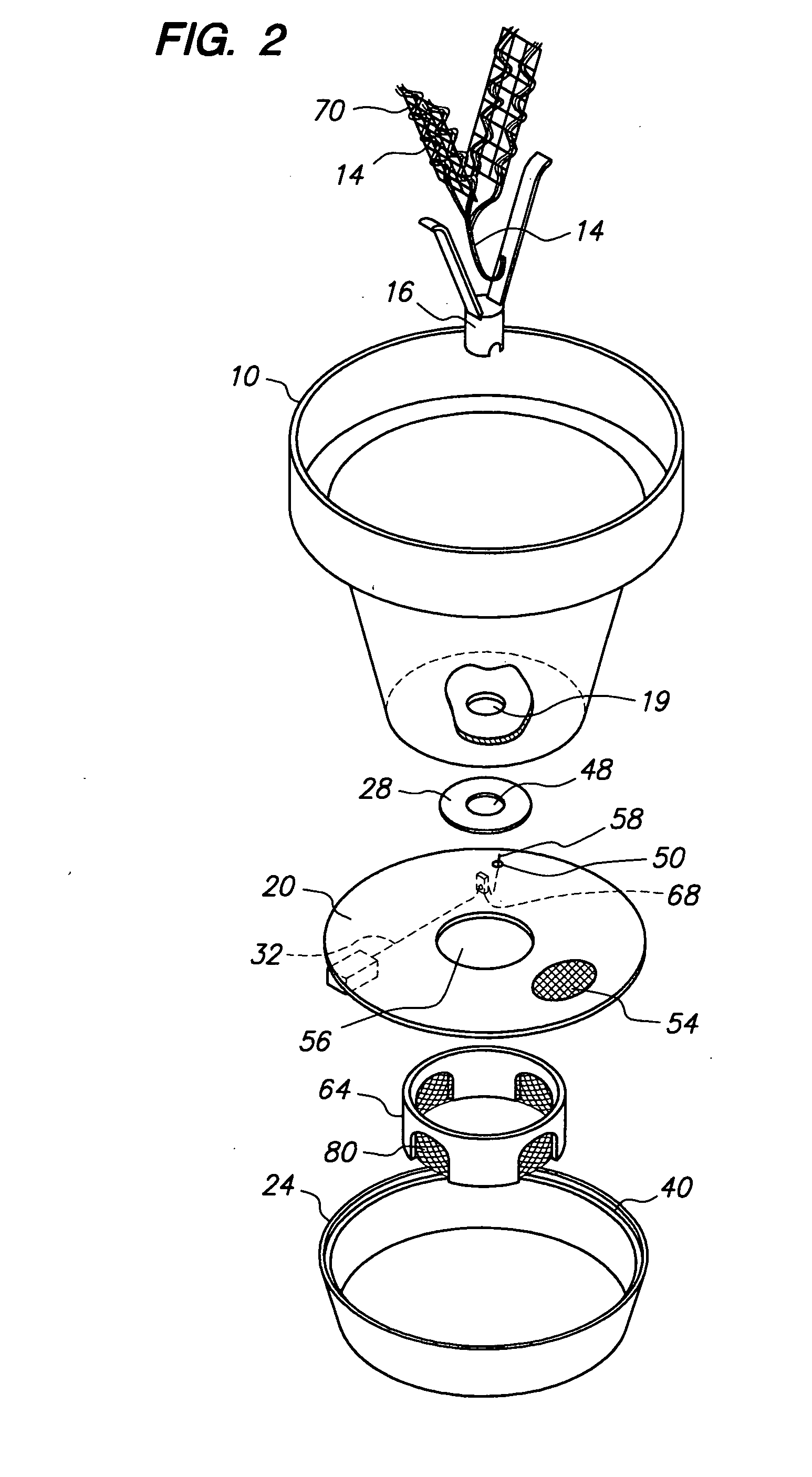However, current potted plant watering systems tend to have significant drawbacks in at least three areas: maintaining capillary wick contact with the soil, ease and ability of controlling the amount of water that is released to the soil, and simplicity in monitoring the levels of remaining water in an associated reservoir.
Current capillary wick systems tend to consist of three main designs, bottom laying, freeform, and vertically positioned, that through use and testing, tend to prove both ineffective in adequately maintaining effective contact between the wick and the soil and ineffective in transmission of
moisture evenly throughout the
plant soil.
Lack of contact can occur when the potted
plant soil becomes dry and the soil contracts and separates from the wick, or because the wick was ineffectively installed in the soil by the potted plant owner such that a wick is not evenly distributed throughout the soil.
This is the same problem with free-form, unsupported wicks.
The only solution for freeform and bottom laying wicks is to press the soil firmly back into the bottom of the pot and therein damaging the delicate root structure; especially of fragile root systems such as orchids.
Another problem with these wick designs is the lack of surface contact available to transmit
moisture between the wick and the soil throughout the plant pot regardless of contact with the soil.
On vertical wick designs, the force of gravity and vibrations from tamping the sides and bottom of the plant pot do not restore contact between the soil and the wick structure.
Testing has also shown that flat, freeform, and vertical wick structures are especially ineffective in transferring fluid at a rate fast enough to compensate for
soil evaporation in dry climates because too little surface area of the wick is exposed to the soil and an insufficient amount of the wick is evenly distributed throughout the soil.
Since the wick is incapable of being consistently and evenly distributed throughout the soil, then the water is distributed only to a particular area of the potted
plant soil and is not distributed uniformly through the potted plant.
Freeform wicks, such as those similar to U.S. Pat. No. 6,418,664 noted earlier, are also ineffective in evenly distributing water throughout the soil.
Freeform wicks do not have adequate contact with the soil because the
exposure to the soil is only through the outer surface of the wick itself.
Therefore, there is too little surface area to transfer and evenly distribute water into the potted plant.
Further, since the potted plant owners themselves are required to lay the
free form wicks into the soil,
human error further guarantees that the wicks will not be evenly distributed to transfer water to the soil in a consistent manner.
Pressure flow controls use friction, screw, or twisting mechanisms to squeeze the wick and reduce the ability of the wick to draw water through it.
All of these involve overly complex mechanical systems that are prone to breakdown and
premature aging and failure; especially in full sun climates.
Other flow control devices require extensive manipulation of wicks and any attempt to insert additional wicks into an already potted plant or any attempt to pull wicks out of an already potted plant further damages the fragile root structure.
More often than not, the owners just resign themselves to either over watering or under watering a plant because they cannot easily control the flow of water.
The readily observed effect is the loss interest in the art of
horticulture as their violets stay bright and green but never bloom or their expensive investment of potted orchids die in too soupy pots.
Finally, owners are often beset with the problem of not knowing when their potted plant water reservoirs need refilling.
The problem here is that testing has demonstrated that one to one ratio float mechanisms like these tend to break off or become damaged because when they are so extended above the water reservoir, then the extended member is prone to getting caught on a passing water hose, child's fingers, or dog chain and being broken off.
Further, these types of float mechanisms are quite prone to becoming clogged and becoming stuck in position and therefore become useless in telling the user how much water remains in the reservoir.
These simple float mechanisms, rising so far above the water reservoir, attract leaves,
lawn clippings, and
dirt and in full sun climates, become quickly impaired.
Further, all of these mechanisms require specially manufactured plant pots or water reservoirs to house the float mechanism.
This means that for current plant pot watering systems, the owners who desire to use their own plant pots, or their own plant pot water reservoirs, lose that opportunity if they desire to have a water measuring capability.
The owners are forced to repot a delicately rooted plant from their own familiar pot into a new plant pot with a
water level measuring
system that is unwieldy and, ultimately, prone to failure.
Finally, the simple single bend float mechanisms that utilize a fulcrum point near an indicating end with a float at the distal end fare no better.
These mechanisms
cut a high and deep radial arc above their indicating surface and not only do they suffer from risk as damage as their no-fulcrum counterparts, but they are confusing to read as the
water level is measured both by distance above an indicating surface as well as the radial arc distance to the left or right of the indicating surface.
Electric monitoring mechanisms are complex, prone to damage from cold and heat and require a source of power.
 Login to View More
Login to View More  Login to View More
Login to View More 


